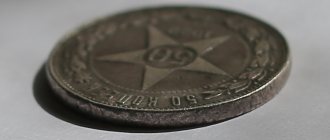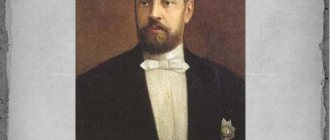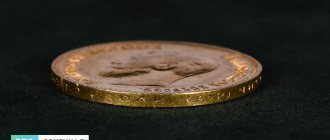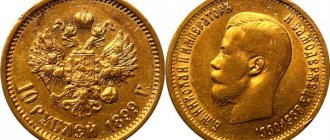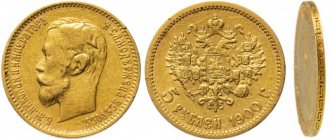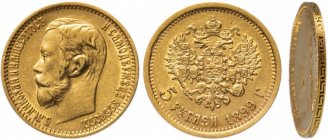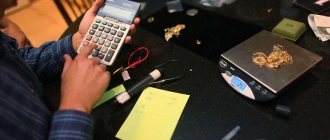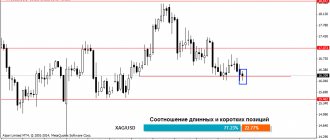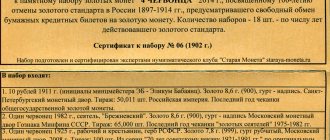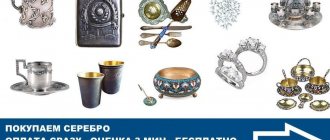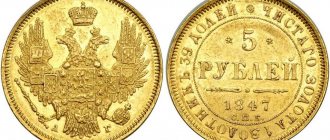After the Civil War and the consolidation of the Bolsheviks in power, the restoration of the country and the determination of a new path of development remained the main task of the government. Those who fled “over the hill,” first the imperialists, and then the bourgeois strata of society, took with them everything that could be taken away. What was left was a ruined and fragmented country with a lot of contradictions, headed by people who had no idea about the structure and management of such a vast territory. The Bolsheviks relied on economics and propaganda. To raise the former, it was necessary to carry out a monetary reform, and it took place in 1921 with the release of new Soviet rubles. Using the experience of imperial coinage, practically copying the royal banknotes, the Bolsheviks issued their own series of silver coins. The characteristics exactly repeated the “Alexandrovsky” and “Nikolaevsky” money.
Characteristics
| Denomination | 50 kopecks |
| Size | 26.67 mm in diameter |
| Material | 900 sterling silver, coin weight - 9 grams |
| Circulation series PL | 26,559,000 copies |
| TR series circulation | 40,000,000 copies |
| Date of issue | 1924 – 1927 |
| Date of withdrawal/withdrawal | 1930 |
| Emission center | State Bank of the USSR |
| Mint | Leningradsky and Birmingham |
Defective coins
Although Soviet coins were carefully checked, defective ones are occasionally found among them. Some defects, such as scratches and abrasions, reduce the price of a coin, while manufacturing defects significantly increase it. Valuable types of defects include the so-called other people's workpieces. For example, one of the 50-kopeck coins of 1990 was made on a blank intended for a twenty-kopeck coin. Since the field of 20 kopecks is smaller, a defective 50-kopeck coin looks like it has been cut off.
Another interesting type of marriage is called a mix-up, when a coin has the obverse or reverse of another coin minted, or the metal or edge is mixed up. So, there is a coin from 1986, on the edge of which the year 1985 is punched. For a circulating coin with the indicated types of defects, you can usually get from several thousand to several tens of thousands of rubles.
Less valuable and common types of marriage are split and bite. Despite the name, the split is not a crack in the coin, but a crack in the die, so on the coin it is expressed as a raised line that follows the shape of the die split.
A bite is the absence of a small piece on a coin due to the fact that the cut blank is hit a second time by the cutting mechanism. Such coins are usually valued at several hundred rubles, but it all depends on the number of defective elements and their sizes.
Appearance and Design
Visually, this coin is quite trivial for our time, but it represents the value of a bygone era, and the photo below confirms this.
Obverse
On the front side there is a relief image of a hammerman with a sledgehammer, in front of which there is an anvil.
Reverse
As for the reverse side of the coin, it is decorated with the coat of arms of the Soviet Union and the inscription “Workers of all countries, unite.”
edge
The edge bears the manufacturer's stamp and displays the mass fraction of silver content.
Soviet anniversary coins 50 kopecks
On October 1, 1967, a commemorative series of coins of the State Bank of the USSR was issued in honor of the fiftieth anniversary of Soviet power. This year, for the memorable anniversary of the 1917 revolution, among other coins, 50 million 50-kopeck copies were issued. The obverse of the commemorative coin features V.I. Lenin against the background of the hammer and sickle of a five-pointed star and the inscription USSR. On the reverse, in addition to the denomination, the inscription appeared: “fifty years of Soviet power.” Since this coin was issued in large quantities and was in circulation, it is not of particular value today and costs about 40-200 rubles, depending on the degree of its preservation.
During the same period, they also released anniversary sets consisting of six copies: 1 ruble, 50, 20, 15, 10 kopecks and an LMD token. In total, approximately 211 thousand sets were produced, and all copies in them had improved quality with more detailed images and a glossy surface. The 50 kopeck coin from this set is valued more expensive, but is also most often sold only in this set. The entire set is estimated at approximately 2.5-3 thousand rubles.
Varieties
It is worth noting that ordinary 50 kopecks from 1924 are not considered collectible and do not arouse much interest. However, during the minting process, products with a number of features appeared. Collectors identify five types of silver fifty dollars that are valuable, with the following differences:
- The blacksmith's head is smaller than usual, and the edge is wider. The number "2" is narrower. There is a dot between the letters T and P on the edge.
- The stamp on the obverse is more convex, and the anvil on the reverse is slightly retracted.
- The obverse is distinguished by its convexity. On the reverse, the numbers “1924” are located below.
- The stamp on the obverse is convex, and the line is narrower compared to other coins. As for the reverse, the worker's head is slightly larger and the anvil is moved back.
- The obverse is the same as in the previous version, but the reverse side is distinguished by a small blacksmith's head, a rectangular blank, a smaller boot and a wide edging. This coin is considered the rarest.
Silver fifty dollars 1924. Rare varieties and their cost.
one silver fifty-kopeck piece 1924
In this article, we will take a closer look at such a popular coin among treasure hunters and numismatists as one fifty-kopeck coin from 1924. The coin is widely distributed, and those treasure hunters who were lucky enough to find a treasure trove of Soviet silver coins probably found fifty-kopeck pieces of the 1924 model in the treasure. In the last couple of years, there has been a tendency towards an increase in the value of these coins, and not only these, but all silver Soviet coins. What this is connected with is all quite simple and prosaic, the crisis is gradually fading away, people have money that can be very successfully invested. Seasoned collectors know that the best investment of their money is buying coins that are in decent condition. Fifty dollars of the 1924 model, as a rule, are perfectly preserved in the ground, so you can always sell them without problems.
So, one fifty-kopeck piece from 1924, which depicts a blacksmith with a hammer. The developers of the coin design managed to convey the whole atmosphere of the hard work of a hammer hammer, for which special thanks to them from the entire numismatist community. The coin is extremely beautiful, made of 900 silver, weighs 10 grams, on the edge of the coin there is the inscription “pure silver 9 grams” (23 10.5 d) - the weight of the coin in shares is indicated in brackets, that is, 2 spools, 10.5 shares of pure silver .
Let's move on directly to the review of rare varieties of fifty-kopeck coins from 1924, because not so long ago at the Vyatka Coin Auction I was lucky enough to observe a real battle of collectors for a seemingly ordinary fifty-kopeck piece of 24 years. So I wondered - what was it about that fifty-kopeck piece that made it leave the auction for as much as 8,000 rubles. After all, the standard price for an ordinary, ordinary fifty-kopeck piece of ’24 is about 300 rubles.
So, all fifty dollars of 1924 are divided into 2 types:
1. On the edge of the coin are the letters PL - minted at the Leningrad Mint, PL - Mintsmeister Pyotr Latyshev. 2. On the edge of the coin are the letters TR - the coins were minted in England (Birmingham), TR - mintmaster Thomas Ross.
The fifty-kopeck coins themselves with different letters practically do not differ in price, but we are interested in rare varieties of this coin.
Rare fifty dollars 1924 TR.
1. If there is no dot between the letters T and P, then this is a rare variety. 2. The globe on the back of the fifty-kopeck piece is noticeably convex; it can also be identified by its rays—the ray of the sun that illuminates the globe—shorter than that of an ordinary fifty-kopeck piece.
Rare fifty dollars 24 years submarine.
1. The first option can be distinguished by the edge of the coin. The inscription on the edge of the coin is made in Old Russian letters, as on the fifty-kopeck coins of the 21-22 model.
2. The obverse side of the coin. A rare variety, called “transitional” among numismatists. That is, the fifty-kopeck piece is something between the fifty-kopeck pieces of the PL and TR. Pay attention - look at the circular inscription “ workers of all countries, unite .” If the comma between the words "countries" and "unite" touches the inner rim of the coin, then this is again a rare variety.
3. Back side of the coin. Very minor differences in the appearance of the hammer worker. The folds of clothing, the main detail - the size of the worker himself is noticeably smaller, he is shorter in stature, so the hammer handle looks visually larger than a regular one. Among collectors, such varieties are conventionally called “thin workers.”
These are, perhaps, all the varieties of the well-known ordinary silver fifty-kopeck coin of 1924. The price for such specimens is quite high, so if you have doubts about the rarity of the fifty-kopeck piece of '24, then feel free to put it up for an online auction, the professionals will sort it out for themselves in no time and there will be quite a stir at the auction, rest assured.
We determine the approximate cost
The price of this coin, like all other coins, depends on a number of factors, which include the current condition, the type of metal used, the presence of a coin defect and the quantity in circulation.
Condition assessment
| Degree of preservation | VF | XF | AU |
| average price | 500 rub. | 700 rub. | 78,000 rub. |
Market price
As for 1 fifty kopeck piece, which has a number of features, the price tag here starts from 20,000 and depends on the features of the appearance of the silver piece.
The most expensive coin is considered to be one with the letters “QP” on the edge, produced in England. When writing the initials of a foreign mintzmeister, the letter “Fita” was used, which was later removed from the alphabet. These banknotes did not go into wide circulation, and further production was carried out with the correct initials of Thomas Ross.
Want to know how much this coin is worth? It was sold at auction in 2007 for almost 3,000,000 rubles at the current exchange rate. The wild cost is due to the fact that only 5 similar products are known.
Further history of the Soviet “fifty dollars”
To summarize, it is worth noting that even after the next Stalinist monetary reform in 1947, which was carried out partly in order to identify the “kurkuls” who profited from the war, as well as to resolve foreign economic issues, the minting of fifty kopecks did not resume.
The Soviet fifty kopecks remained those two silver coins of the 1921 and 1924 models, which were soon deprived of their solvency, but remained with the population as part of the memory of that era - or as a nine-gram piece of silver from which jewelry or keychains were made. Later, after the collapse of the USSR, the coins were sold as souvenirs to foreigners for pennies. Today you can often see lots with Soviet fifty-kopeck coins at auctions in America, Germany, Great Britain or even Australia at a price that is several times higher than their ability to pay at that time.
As a rule, numismatists are divided into several categories: there are those who collect exclusively Soviet coins by face value, some by year, some do not recognize copper-nickel coins of the late USSR at all, and prefer royal coins of the Romanov reign. There is a category of collectors who are only interested in English pounds, shillings and pence. The first Soviet fifty-kopeck coins also have fans, and although the price for them is not as high as, for example, coins of the pre-Nicholas period or European thalers, it is still possible to have in your collection a fifty-kopeck piece that your ancestor may have held in his hands, and paying them back, giving his last to feed your great-grandfather in the harsh days of the post-revolutionary period, fills any Russian person with pride.
How much is a 50 kopeck USSR coin worth? Methods for determining price
The first way to determine the value of a particular fifty-kopeck piece is to work with catalogs of Soviet coins compiled by experienced numismatists. Among the most famous of them is the work of A. Fedorin. Also, tables often contain data from the catalogs of D. Tilizhinsky and V. Kapustin. They indicate the name of the varieties for coins of each denomination, year and their approximate value. Thus, for the fifty-kopeck coins of 1924 alone, approximately two dozen varieties are described in the catalogs. And at this step a problem arises for the beginning numismatist, since beginners often make mistakes in identifying varieties.
Even more questions arise when studying the cost column. Different authors give their opinion on this matter based on their experience, and specific figures may differ markedly. As practice shows, the declared and final prices for leaving auctions also differ significantly from those given in these catalogs. Here, various factors already influence: how many offers are on the market, what is the state of the market itself, how many participants gathered at the auction, what are the seller’s expectations and other points. Also, when studying these catalogs, it is worth taking into account inflation, since prices in the year of their release were noticeably different from today's prices.
The second method is to hire an experienced appraiser who is knowledgeable about coins from the Soviet period. Since many USSR coins are not of particular value, if in doubt, you can post photographs of your specimens in the numismatist community and ask them to determine the approximate price. An important condition here is to write in a suitable topic and post clear photographs from different angles. If you suspect a valuable coin, it is better to contact an appraiser in person so that he can correctly determine its value.
Where to buy coins of 50 kopecks USSR
There are many places that offer Soviet coins. They are sold in coin stores, second-hand bookstores or antique stores. It is not uncommon to see bags of Soviet coins at flea markets, since the time for many of them to go out of circulation is recent by antique standards. True, it is not easy to find a valuable variety in such bags, and you need to have good experience in identifying varieties.
Expensive items are usually offered at auctions held online or in auction houses. Bidding on auction sites is in many ways more accessible in terms of requirements, conditions and price. Bidding in auction houses is more profitable for sellers, but also more labor-intensive, and also requires round sums for buyers, since particularly interesting specimens cost hundreds of thousands and millions of rubles.
When purchasing, it is important to remain vigilant and not receive a copy of the coin instead of its original. And there are a huge number of such copies on the market today, and with the development of new technologies they are becoming more and more advanced.
